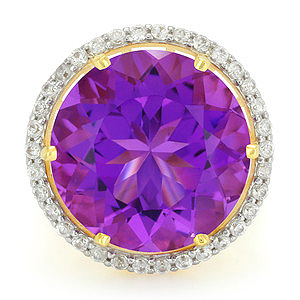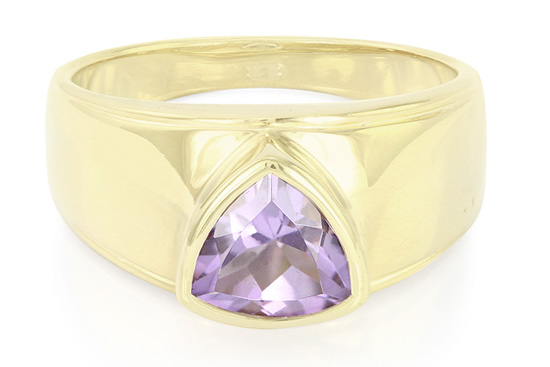The episcopal insignia is the ring, the crozier, the mitre and the breast cross. It is they who distinguish the prelates. These insignias have an ancient origin and are a sign of the authority of the wearer. In the Church, its spiritual significance is supplemented, especially in liturgical ceremonies.
The Vatican’s precious treasure has countless stories behind it in addition to the actual astounding value of the jewels.
In the case of the bishop’s ring: it is a symbol of spiritual union with the Church, representing its loyalty and engagement to the Holy Institution. It is worn on the ring finger of the right hand.

Brejinho Amethyst Yellow Gold Ring
The Pope’s ring is called the “Fisher Ring“, alluding St. Peter to the apostle and his work as a fisherman. Some argue the importance of the Pope’s role as “fisherman” of the faithful. The Fischer ring shows the picture of St. Peter fishing in a boat, framed by the name of the current “Holy Father” in Latin script.
The earliest mention of the ring dates back to a letter from Clement IV in 1265, the ring was used to seal the Pope’s private correspondence. When the pontiff dies, the ring is destroyed with a silver club so that it is not abused.

Bolivian Amethyst Men’s Gold Vermeil Ring-Rocks&Co.
It was Benedict XVI who decided to reintroduce the tradition of the official use of the Fishermen’s Ring. Claudio Franchi was commissioned in 2005 for the ring of Pope Benedicto XVI. The design for the ring was inspired by a painting by Michelangelo. More than 200 drawings were required for the final concept. The elliptical shape represents the square in front of St. Peter’s Basilica. The ring is made of 35 grams of pure gold. Eight goldsmiths worked on it for two weeks.

Pope John Paul II -Wikipedia
When Benedict XVI resigned, something very unusual happened. Because the Pope had not died, the ring was in fact not destroyed, but a “biffatura”, that is, the “ring was annulled with a cross”. A cross was cut into the ring.
Pope Francis did not want a “fisherman’s ring” made of gold. He ordered a silver ring from “Bodega Barcelonesa Capdevilla”. A workshop in Barcelona that has specialized in religious ornaments since 1905.
Of course, the spiritual value of episcopal jewellery is immense, but its economic value is no less.
Pope Paul VI donated two important jewels to raise money for charity: the breast cross and his diamond platinum ring. This happened during a visit to the United Nations in 1965. He wanted the objects to be sold in auctions and the proceeds to be used to alleviate human suffering. Both objects were purchased in 1967 for US$ 64,000 by the jeweller Harry Levinson from Chicago.
The breast cross was already worn by the first Christians in the 13th century. The breast cross of Paul VI was made of 750 gold and set with 12 diamonds that were between 3 and 8.66 ct as well as Colombian emeralds. The fate of this jewel is interesting. It ended on eBay. The fact that a jewel of so much spiritual value lands on and is sold on an Internet platform is something that should make us all think.
The sacred jewels are currently owned by M.S. Rau Antiques in New Orleans and are being offered for US$ 1.9 million.
“These two pieces are not only historically significant, they are also extraordinary because of the fact that the papal jewellery rarely comes on the market,” said Bill Rau, owner of M.S. Rau Antiques New Orleans.
And that was the last news about the jewels so far. Stay tuned!




